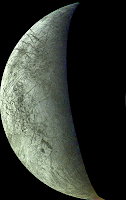5. 2001, The red tinge of Jupiter's moon Europa proposed to be due to frozen bits of bacteria, which also helps explain the mysterious infrared signal it gives offAlien microbes might be behind Europa's red tinge, suggested NASA researchers in 2001. Though the surface is mostly ice, data shows it reflects infrared radiation in an odd manner. That suggests that something - magnesium salts perhaps - are binding it together. But no one has been able to come up with the right combination of compounds to make sense of the data.
Intriguingly, the infrared spectra of some Earthly bacteria - those that thrive in extreme conditions - fits the data at least as well as magnesium salts. Plus, some are red and brown in colour, perhaps explaining the moon's ruddy complexion. Though bacteria might find it difficult to survive in the scant atmosphere and -170°C surface temperature of Europa, they might survive in the warmer liquid interior. Geological activity could then spew them out periodically to be flash frozen on the surface.
 6. 2002, Russian scientists argue that a mysterious radiation-proof species of microbe may have evolved on Mars
6. 2002, Russian scientists argue that a mysterious radiation-proof species of microbe may have evolved on Mars
In 2002 Russian astrobiologists claimed that super-hardy
Deinococcus radiourans evolved on Mars. The microbe can survive several thousand times the radiation dose that would kill a human.
The Russians zapped a population of the bacteria with enough radiation to kill 99.9%, allowed the survivors to repopulate, before repeating the cycle. After 44 rounds it took 50 times the original dose of radiation. They calculated that it would take many thousands of these cycles to make common microbe
E.coli as resilient as
Deinococcus. And on Earth it takes between a million and 100 million years to encounter each dose of radiation. Therefore there just has not been enough time in life's 3.8 billion year history on Earth for such resistance to have evolved, they claim.
By contrast, the surface of Mars, unprotected by a dense atmosphere, is bombarded with so much radiation that the bugs could receive the same dose in just a few hundred thousand years. The researchers argue that
Deinococcus's ancestors were flung off of Mars by an asteroid and fell to Earth on meteorites. Other experts remain sceptical.
 7. 2002, Chemical hints of life are found in old data from Venus probes and landers. Could microbes exist in Venusian clouds?
7. 2002, Chemical hints of life are found in old data from Venus probes and landers. Could microbes exist in Venusian clouds?
Life in Venus' clouds may be the best way to explain some curious anomalies in the composition of its atmosphere, claimed University of Texas astrobiologists in 2002. They scoured data from NASA's Pioneer and Magellan space probes and from Russia's Venera Venus-lander missions of the 1970s.
Solar radiation and lightning should be generating masses of carbon monoxide on Venus, yet it is rare, as though something is removing it. Hydrogen sulphide and sulphur dioxide are both present too. These readily react together, and are not usually found co-existing, unless some process constantly is churning them out. Most mysterious is the presence of carbonyl sulphide. This is only produced by microbes or catalysts on Earth, and not by any other known inorganic process.
The researchers' suggested solution to this conundrum is that microbes live in the Venusian atmosphere. Venus's searing hot, acidic surface may be prohibitive to life, but conditions 50 kilometres up in the atmosphere are more hospitable and moist, with a temperature of 70°C and a pressure similar to Earth.
 8. 2003, Sulphur traces on Jupiter's moon Europa may be the waste products of underground bacterial colonies
8. 2003, Sulphur traces on Jupiter's moon Europa may be the waste products of underground bacterial colonies
In 2003, Italian scientists hypothesised that sulphur traces on Europa might be a sign of alien life. The compounds were first detected by the Galileo space probe, along with evidence for a volcanically-warmed ocean beneath the moon's icy crust.
The sulphur signatures look similar to the waste-products of bacteria, which get locked into the surface ice of lakes in Antarctica on Earth. The bacteria survive in the water below, and similar bacteria might also thrive below Europa's surface, the researchers suggest. Others experts rejected the idea, suggesting that the sulphur somehow originates from the neighbouring moon Io, where it is found in abundance.
 9. 2004, Methane in the Martian atmosphere hints at microbial metabolism
9. 2004, Methane in the Martian atmosphere hints at microbial metabolism
In 2004 three groups - using telescopes on Earth and the European Space Agency's Mars Express orbiting space probe - independently turned up evidence of methane in the atmosphere. Nearly all methane in our own atmosphere is produced by bacteria and other life.
Methane could also be generated by volcanism, the thawing of frozen underground deposits, or delivered by comet impacts. However, the source has to be recent, as the gas is rapidly destroyed on Mars or escapes into space.
In January 2005, an ESA scientist controversially announced that he had also found evidence of formaldehyde, produced by the oxidation of methane. If this is proved it will strengthen the case for microbes, as a whopping 2.5 million tonnes of methane per year would be required to create the quantity of formaldehyde postulated to exist.
There are ways to confirm the presence of the gas, but scientists will need to get the equipment to Mars first.